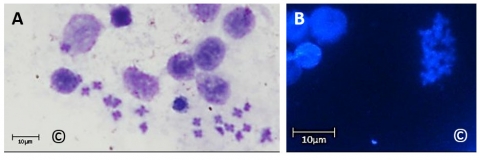
The sexual determinism is a key process of the reproduction, essential to the life cycle. This ambitious project aimed at understanding the determinism of the sex in 2 Molluscs, the oyster Crassostrea gigas and the cuttlefish Sepia officinalis. These organisms are species of economic importance, which present very different life cycles and modes of reproduction, to the image of their Phylum.
The objective was to locate, for the 1st time in these Molluscs, by karyotyping and localization by Fluorescent In situ Hybridization (FISH) on chromosomes, known and well conserved genes of the male (Dsx/Dmrt1) and female (FoxL2) sex determinism.
The main part of the experiments was carried out by a student, Floriane Maillard, within the framework of its Master 2 degree. The majority of the results was obtained in the oyster C. gigas, successive irregular hermaphrodite mollusc. For this species, an effective protocol of obtaining karyotypes was defined starting from gills and of gonadic areas of individuals. It made it possible to have of an important concentration in nuclei and a good dispersion of the chromosomes, visible in colorimetry (Giemsa) and in fluorescence (DAPI) (Fig 1). For the approach in FISH, 2 fragments of DNA covering approximately 5Kpb (50%) of the dsx gene were amplified by PCR and marked by the technique of “nick translation” (incorporation of dUTP coupled with the digoxigenin). In spite of many optimizations of protocol, in situ hybridization using these probes did not make it possible to locate the dsx gene on the chromosomes. This technique, once all made optimizations, will be pioneer in oyster and cuttlefish. It will not only allow to apprehend the sexual determinism of these species, a comparative approach but also will answer many physiological questions in link with the life cycle of these animals.
Contact:
LELONG Christophe (christophe.lelong@unicaen.fr)
MARTINEZ Anne-Sophie (anne-sophie.martinez@unicaen.fr)
BONNAUD-PONTICELLI Laure (laure.bonnaud@mnhn.fr)
Team 2 « Reproduction and development of aquatic organisms: evolution, adaptation, regulations »
